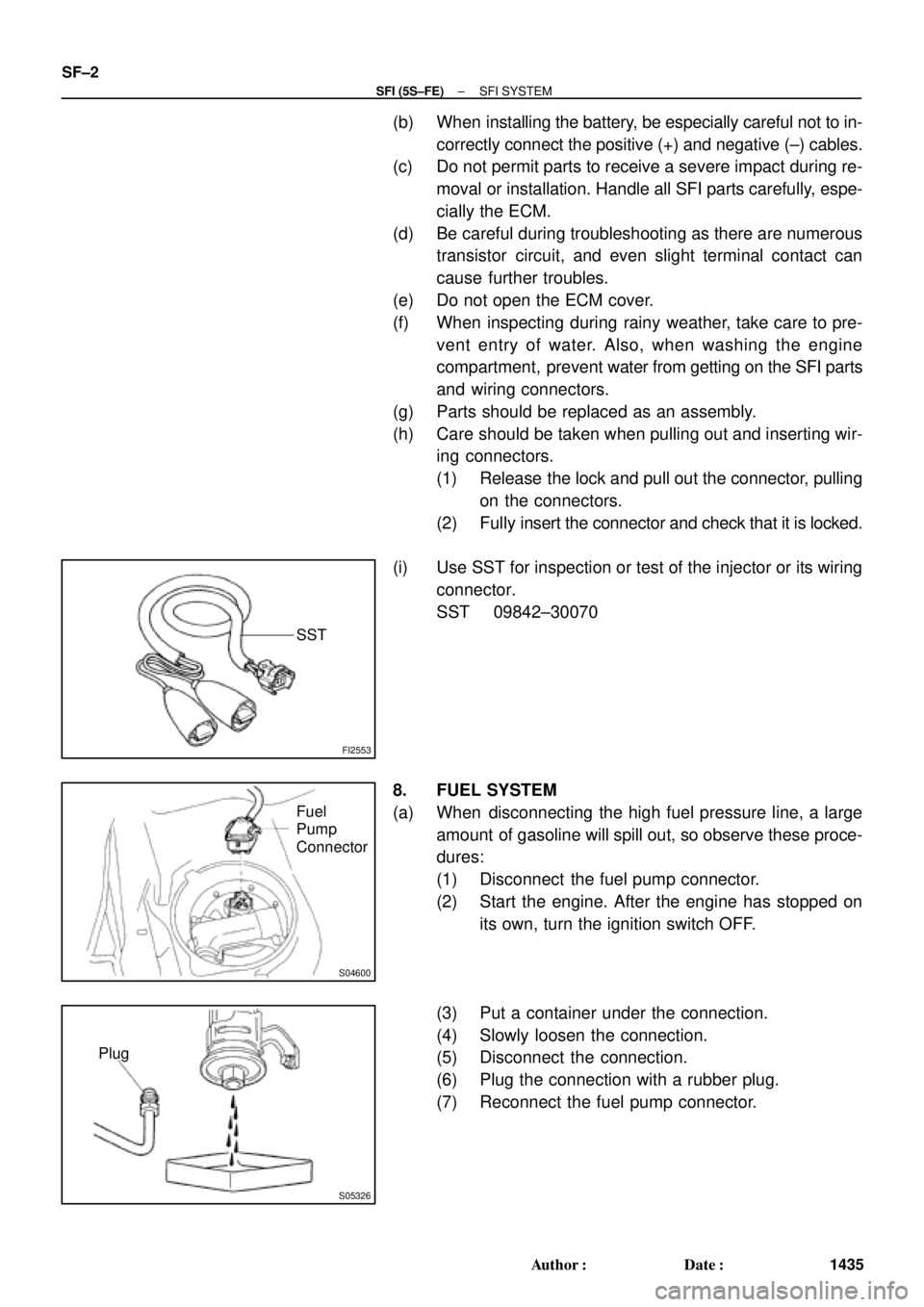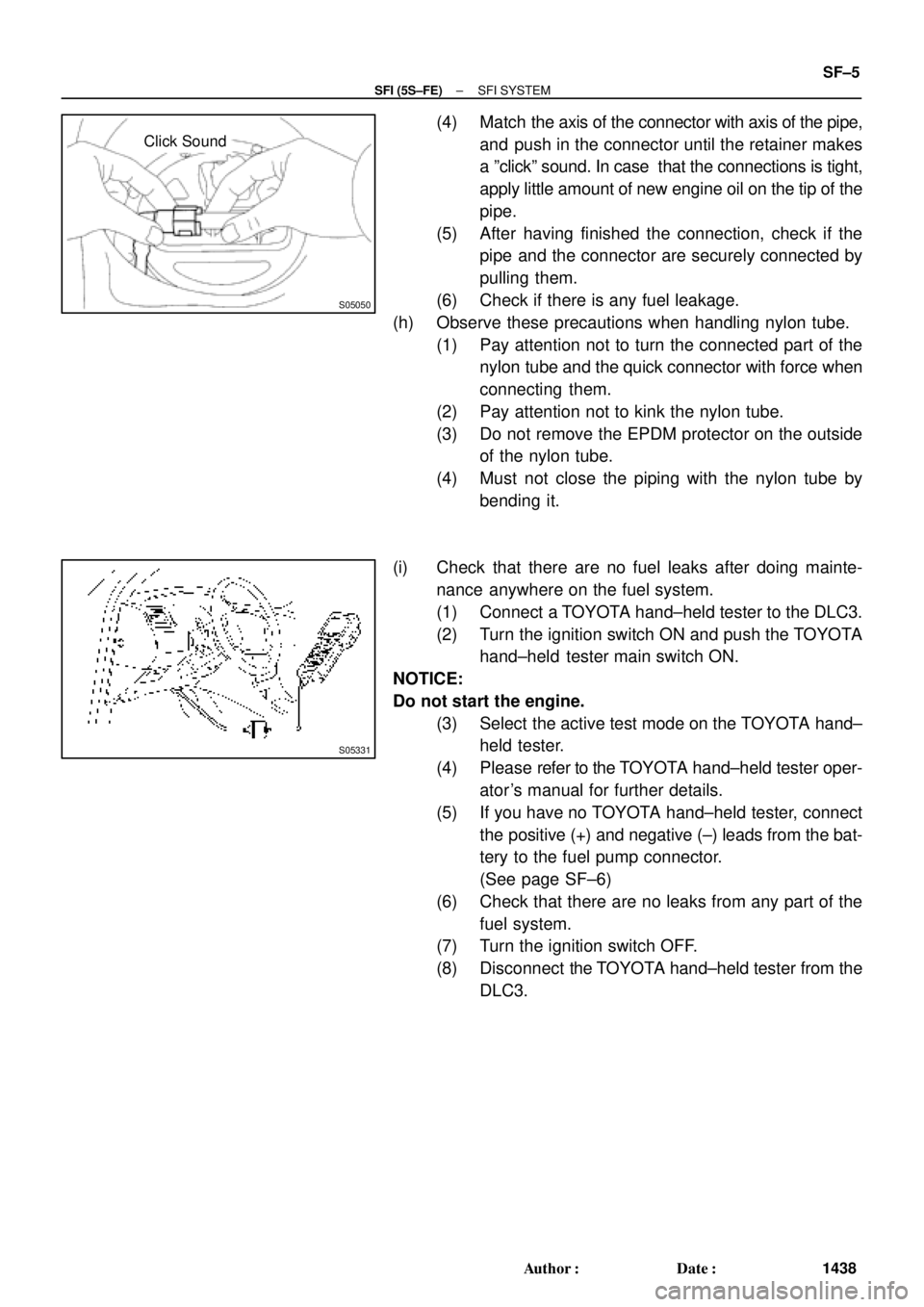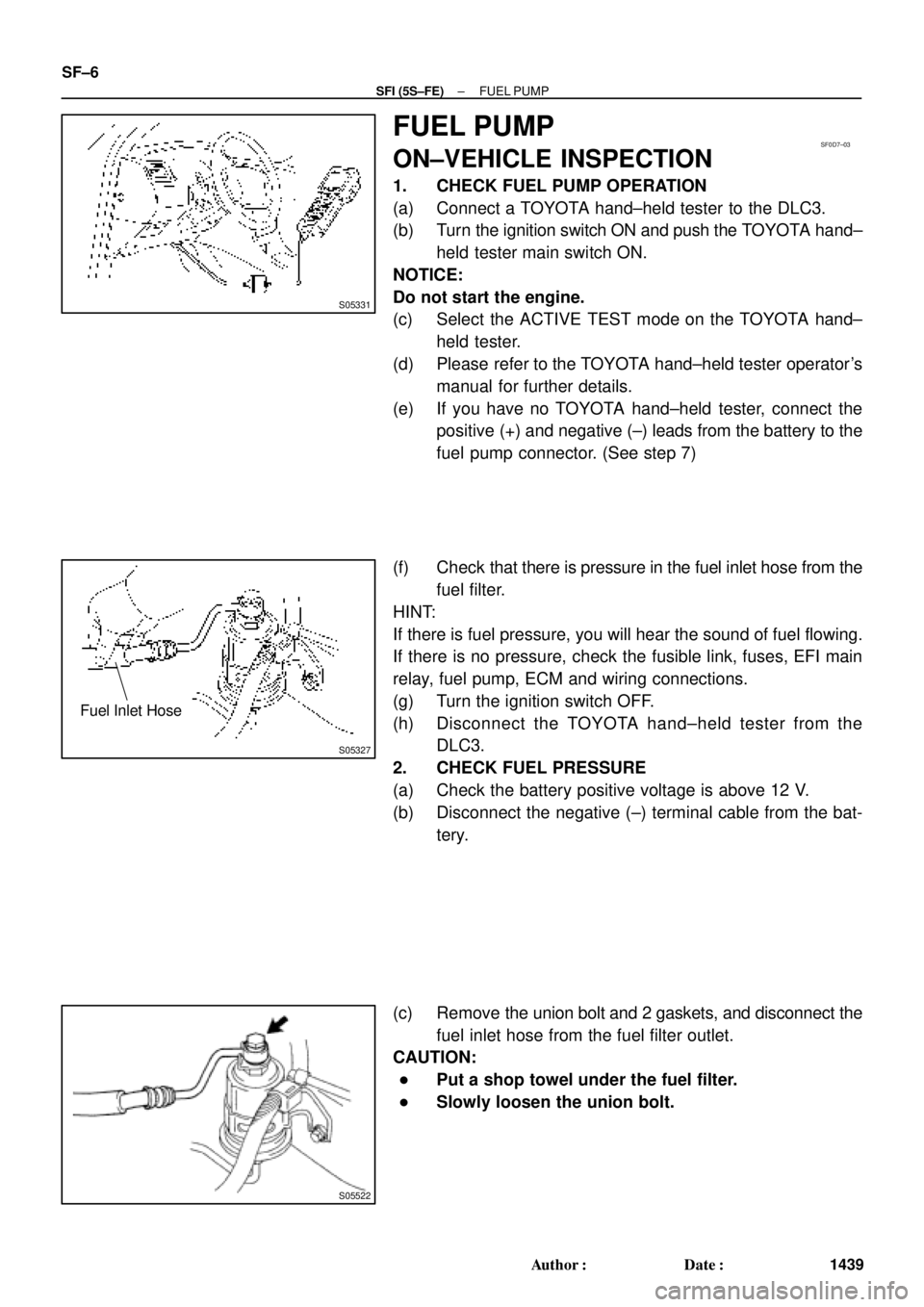Page 3993 of 4770
SS0AM±03
± SERVICE SPECIFICATIONSIGNITION (5S±FE)
SS±31
194 Author�: Date�:
IGNITION (5S±FE)
SERVICE DATA
Firing order±1 ± 3 ± 4 ± 2
High±tension
cordResistance Maximum25 kW per cord
Spark plugRecommended spark plug DENSO made
NGK made
Correct electrode gap for new spark plug
Maximum electrode gap for used spark plugPK20TR11
BKR6EKPB11
1.1 mm (0.043 in.)
1.3 mm (0.051 in.)
Ignition coilSecondary coil resistance at cold
at hot9.7 ± 16.7 kW
12.4 ± 19.6 kW
Camshaft
position
sensorResistance at cold
at hot835 ± 1,400 W
1,060 ± 1,645 W
Crankshaft
position
sensorResistance at cold
at hot985 ± 1,600 W
1,265 ± 1,890 W
Page 3994 of 4770
SS0AN±03
SS±32
± SERVICE SPECIFICATIONSIGNITION (5S±FE)
195 Author�: Date�:
TORQUE SPECIFICATION
Part tightenedN´mkgf´cmft´lbf
Spark plug x Cylinder head1818013
Ignition coil x No.2 intake manifold stay9.810087 in.´lbf
No.2 intake manifold stay x Cylinder head2121415
No.2 intake manifold stay x Intake manifold4242831
Camshaft position sensor assembly x Cylinder head9.59784 in.´lbf
Crankshaft position sensor x Oil pump9.59784 in.´lbf
Page 3995 of 4770
SS07G±02
± SERVICE SPECIFICATIONSIGNITION (1MZ±FE)
SS±33
196 Author�: Date�:
IGNITION (1MZ±FE)
SERVICE DATA
Firing order±1 ± 2 ± 3 ± 4 ± 5 ± 6
High±tension
cordResistance Maximum25 kW per cord
Spark plugRecommended spark plug DENSO made
NGK made
Correct electrode gap for new plug
Maximum electrode gap for used plugPK20TR11
BKR6EKPB11
1.1 mm (0.043 in.)
1.3 mm (0.051 in.)
Ignition coilPrimary coil resistance at cold
at hot
Secondary coil resistance
AISAN made at cold
at hot
Diamond made at cold
at hot0.70 ± 0.94 W
0.85 ± 1.10 W
10.8 ± 14.9 kW
13.1 ± 17.5 kW
6.8 ± 11.7 kW
8.6 ± 13.7 kW
Camshaft
position
sensorResistance
DENSO made at cold
at hot
Wabash made at cold
at hot
835 ± 1,400 W
1,060 ± 1,645 W
1,690 ± 2,560 W
2,145 ± 3,010 W
Crankshaft
position
sensorResistance at cold
at hot1,630 ± 2,740 W
2,065 ± 3,225 W
Page 3996 of 4770
SS07H±01
SS±34
± SERVICE SPECIFICATIONSIGNITION (1MZ±FE)
197 Author�: Date�:
TORQUE SPECIFICATION
Part tightenedN´mkgf´cmft´lbf
Spark plug x Cylinder head1818013
Ignition coil x Cylinder head88069 in.´lbf
Camshaft position sensor x Cylinder head88069 in.´lbf
Crankshaft position sensor x Oil pump88069 in.´lbf
Page 4035 of 4770

SF0D6±04
± SFI (5S±FE)SFI SYSTEM
SF±1
1434 Author�: Date�:
SFI SYSTEM
PRECAUTION
1. BEFORE WORKING ON FUEL SYSTEM, DISCON-
NECT NEGATIVE (±) TERMINAL CABLE FROM BAT-
TERY
HINT:
Any diagnostic trouble code retained by the computer will be
erased when the negative (±) terminal cable is removed from
the battery.
Therefore, if necessary, read the diagnosis before removing the
negative (±) terminal cable from the battery.
2. DO NOT SMOKE OR WORK NEAR AN OPEN FLAME
WHEN WORKING ON THE FUEL SYSTEM
3. KEEP GASOLINE AWAY FROM RUBBER OR LEATH-
ER PARTS
4. MAINTENANCE PRECAUTIONS
(a) In event of engine misfire, these precautions should be
taken.
(1) Check proper connection to battery terminals, etc.
(2) After repair work, check that the ignition coil termi-
nals and all other ignition system lines are recon-
nected securely.
(3) When cleaning the engine compartment, be espe-
cially careful to protect the electrical system from
water.
(b) Precautions when handling the oxygen sensor.
(1) Do not allow oxygen sensor to drop or hit against an
object.
(2) Do not allow the sensor to come into contact with
water.
5. IF VEHICLE IS EQUIPPED WITH MOBILE RADIO SYS-
TEM (HAM, CB, ETC.)
If the vehicle is equipped with a mobile communication system,
refer to the precaution in the IN section.
6. AIR INDUCTION SYSTEM
(a) Separation of the engine oil dipstick, oil filler cap, PCV
hose, etc. may cause the engine to run out of tune.
(b) Disconnection, looseness or cracks in the parts of the air
induction system between the throttle body and cylinder
head will allow air suction and cause the engine to run out
of tune.
7. ELECTRONIC CONTROL SYSTEM
(a) Before removing SFI wiring connectors, terminals, etc.,
first disconnect the power by either turning the ignition
switch OFF or disconnecting the negative (±) terminal
cable from the battery.
HINT:
Always check the diagnostic trouble code before disconnecting
the negative (±) terminal cable from the battery.
Page 4036 of 4770

FI2553
SST
S04600
Fuel
Pump
Connector
S05326
Plug SF±2
± SFI (5S±FE)SFI SYSTEM
1435 Author�: Date�:
(b) When installing the battery, be especially careful not to in-
correctly connect the positive (+) and negative (±) cables.
(c) Do not permit parts to receive a severe impact during re-
moval or installation. Handle all SFI parts carefully, espe-
cially the ECM.
(d) Be careful during troubleshooting as there are numerous
transistor circuit, and even slight terminal contact can
cause further troubles.
(e) Do not open the ECM cover.
(f) When inspecting during rainy weather, take care to pre-
vent entry of water. Also, when washing the engine
compartment, prevent water from getting on the SFI parts
and wiring connectors.
(g) Parts should be replaced as an assembly.
(h) Care should be taken when pulling out and inserting wir-
ing connectors.
(1) Release the lock and pull out the connector, pulling
on the connectors.
(2) Fully insert the connector and check that it is locked.
(i) Use SST for inspection or test of the injector or its wiring
connector.
SST 09842±30070
8. FUEL SYSTEM
(a) When disconnecting the high fuel pressure line, a large
amount of gasoline will spill out, so observe these proce-
dures:
(1) Disconnect the fuel pump connector.
(2) Start the engine. After the engine has stopped on
its own, turn the ignition switch OFF.
(3) Put a container under the connection.
(4) Slowly loosen the connection.
(5) Disconnect the connection.
(6) Plug the connection with a rubber plug.
(7) Reconnect the fuel pump connector.
Page 4039 of 4770

S05050
Click Sound
S05331
± SFI (5S±FE)SFI SYSTEM
SF±5
1438 Author�: Date�:
(4) Match the axis of the connector with axis of the pipe,
and push in the connector until the retainer makes
a ºclickº sound. In case that the connections is tight,
apply little amount of new engine oil on the tip of the
pipe.
(5) After having finished the connection, check if the
pipe and the connector are securely connected by
pulling them.
(6) Check if there is any fuel leakage.
(h) Observe these precautions when handling nylon tube.
(1) Pay attention not to turn the connected part of the
nylon tube and the quick connector with force when
connecting them.
(2) Pay attention not to kink the nylon tube.
(3) Do not remove the EPDM protector on the outside
of the nylon tube.
(4) Must not close the piping with the nylon tube by
bending it.
(i) Check that there are no fuel leaks after doing mainte-
nance anywhere on the fuel system.
(1) Connect a TOYOTA hand±held tester to the DLC3.
(2) Turn the ignition switch ON and push the TOYOTA
hand±held tester main switch ON.
NOTICE:
Do not start the engine.
(3) Select the active test mode on the TOYOTA hand±
held tester.
(4) Please refer to the TOYOTA hand±held tester oper-
ator 's manual for further details.
(5) If you have no TOYOTA hand±held tester, connect
the positive (+) and negative (±) leads from the bat-
tery to the fuel pump connector.
(See page SF±6)
(6) Check that there are no leaks from any part of the
fuel system.
(7) Turn the ignition switch OFF.
(8) Disconnect the TOYOTA hand±held tester from the
DLC3.
Page 4040 of 4770

S05331
SF0D7±03
S05327
Fuel Inlet Hose
S05522
SF±6
± SFI (5S±FE)FUEL PUMP
1439 Author�: Date�:
FUEL PUMP
ON±VEHICLE INSPECTION
1. CHECK FUEL PUMP OPERATION
(a) Connect a TOYOTA hand±held tester to the DLC3.
(b) Turn the ignition switch ON and push the TOYOTA hand±
held tester main switch ON.
NOTICE:
Do not start the engine.
(c) Select the ACTIVE TEST mode on the TOYOTA hand±
held tester.
(d) Please refer to the TOYOTA hand±held tester operator's
manual for further details.
(e) If you have no TOYOTA hand±held tester, connect the
positive (+) and negative (±) leads from the battery to the
fuel pump connector. (See step 7)
(f) Check that there is pressure in the fuel inlet hose from the
fuel filter.
HINT:
If there is fuel pressure, you will hear the sound of fuel flowing.
If there is no pressure, check the fusible link, fuses, EFI main
relay, fuel pump, ECM and wiring connections.
(g) Turn the ignition switch OFF.
(h) Disconnect the TOYOTA hand±held tester from the
DLC3.
2. CHECK FUEL PRESSURE
(a) Check the battery positive voltage is above 12 V.
(b) Disconnect the negative (±) terminal cable from the bat-
tery.
(c) Remove the union bolt and 2 gaskets, and disconnect the
fuel inlet hose from the fuel filter outlet.
CAUTION:
�Put a shop towel under the fuel filter.
�Slowly loosen the union bolt.